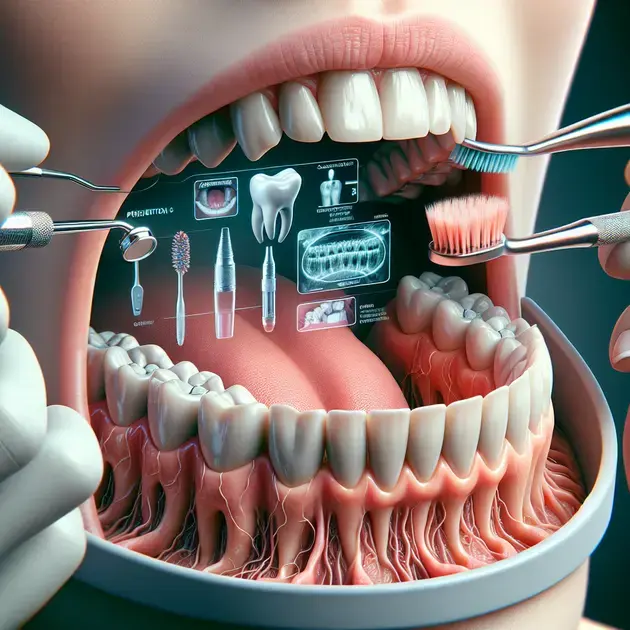Are you experiencing the discomfort of receding gums? In this article, we will explore the causes, symptoms, and various treatment options available for receding gums. It is essential to understand the underlying factors contributing to this condition in order to address it effectively.
Recent studies have shown a significant increase in the prevalence of receding gums due to poor oral hygiene habits and genetic predisposition. By learning more about the causes and recognizing the symptoms early on, individuals can take proactive steps to prevent further gum recession and maintain optimal oral health.

Causes of Receding Gums
Receding gums can be caused by several factors, including poor oral hygiene practices, genetics, hormonal changes, tobacco use, and gum disease. Poor brushing technique and aggressive brushing can also contribute to gum recession. To prevent receding gums, it is important to brush and floss regularly using proper techniques. Websites like Colgate.com offer detailed guides on proper oral hygiene practices to maintain gum health.
Genetics play a role in determining the thickness of your gum tissue, which can affect the likelihood of gum recession. If your family has a history of gum disease or receding gums, you may be more susceptible to experiencing the same issues. Visiting a periodontist for a comprehensive evaluation can provide insights into your genetic risk factors for gum recession.
Hormonal changes, such as those experienced during puberty, pregnancy, or menopause, can increase the risk of gum recession due to fluctuations in hormone levels. It is essential to maintain regular dental check-ups during these periods to monitor any changes in your gum health. Websites like WebMD provide information on how hormonal changes can impact oral health.
Tobacco use, both smoking and smokeless tobacco, is a significant risk factor for gum disease and gum recession. The chemicals in tobacco products can damage the gum tissue and lead to recession over time. Quitting smoking and seeking support from cessation programs like Smokefree.gov can help prevent further gum recession.
Gum disease, specifically periodontitis, is a leading cause of receding gums. This bacterial infection can destroy the gum tissue and underlying bone, leading to gum recession and tooth loss if left untreated. Visiting a dentist regularly and websites like Perio.org can provide information on the symptoms and treatment of gum disease to prevent further recession.
Common Symptoms to Watch For
There are several common symptoms associated with receding gums that individuals should watch for to identify the early signs of gum recession. One of the primary symptoms is tooth sensitivity, especially to hot and cold temperatures, as the exposed tooth roots become more sensitive. Using desensitizing toothpaste like Sensodyne, available at most pharmacies, can help alleviate discomfort.
Bleeding gums, particularly during brushing or flossing, can indicate gum inflammation and potential recession. Incorporating an antimicrobial mouthwash like Listerine into your oral care routine can help reduce bacteria and prevent further gum issues. Websites like Crest.com offer information on how to choose the right mouthwash for gum health.
Longer-looking teeth or a change in the appearance of your smile may be signs of gum recession. Monitoring changes in the alignment and length of your teeth can help you detect gum recession early. Websites like Invisalign.com provide information on orthodontic treatments to correct tooth positioning affected by gum recession.
Gum tenderness or pain when chewing can signal gum recession and potential gum disease. It is crucial to consult with a dentist if you experience persistent gum discomfort to prevent further damage. Websites like ADA.org offer resources to find a licensed dentist in your area for professional evaluation and treatment.
Changes in the gum line, such as the appearance of notches or gaps between teeth and gums, can indicate gum recession. Tracking changes in your gum line with photos or videos can help you and your dentist assess the progression of gum recession over time. Websites like Oralb.com provide tips on how to monitor changes in your gum health at home.
Effective Treatment Options
When it comes to treating receding gums, several effective options can help slow down or stop the progression of gum recession. Scaling and root planing, a deep cleaning procedure performed by a dental hygienist or periodontist, can remove plaque and tartar buildup below the gumline to promote gum reattachment. Websites like MouthHealthy.org offer information on this common treatment for gum disease.
Gum grafting, a surgical procedure where tissue is taken from the roof of the mouth or a tissue bank and attached to the receded gums, can help cover exposed tooth roots and prevent further recession. Consulting with a periodontist who specializes in gum grafting can provide the best outcome for restoring gum health. Websites like Perio.org feature resources on gum grafting procedures and recovery.
Pinhole surgical technique (PST) is a minimally invasive procedure where a small hole is made in the gum tissue to loosen it and reposition it over the exposed roots. This technique can be less painful and require a shorter recovery time compared to traditional gum grafting. Finding a dentist trained in PST through websites like Misch.com can help you explore this innovative treatment option.
Using a gum recession mouthguard at night can help alleviate pressure on the teeth and gums caused by clenching or grinding, reducing the risk of further recession. Custom mouthguards prescribed by a dentist can provide a comfortable and effective solution for protecting your gums while sleeping. Websites like Dentakit.com offer information on ordering custom-fit mouthguards for gum recession.
Regular professional cleanings and check-ups with your dentist or periodontist are essential to monitor the progression of gum recession and ensure early intervention if needed. Maintaining a consistent oral care routine and following the treatment recommendations provided by your dental healthcare provider can help prevent further gum recession and preserve your oral health. Websites like Opineoutpost.com offer reviews and recommendations on oral care products to support your gum health journey.

Preventive Measures for Gum Recession
Gum recession is a common dental issue that can lead to a variety of problems if left untreated. Fortunately, there are several preventive measures you can take to protect your gum health and avoid recession. One important step is to maintain good oral hygiene practices, such as brushing your teeth twice a day and flossing regularly. This helps remove plaque and bacteria that can contribute to gum disease and recession.
Another preventive measure is to have regular dental check-ups and cleanings. Your dentist can identify early signs of gum recession and provide treatment to prevent further deterioration. It’s also essential to avoid tobacco products, as smoking can increase the risk of gum disease and recession. Additionally, a balanced diet rich in vitamins and minerals can support overall gum health and reduce the likelihood of recession.
Protecting your gums from injury is also important in preventing recession. Avoiding habits like teeth grinding and using a mouthguard during sports activities can help prevent trauma to the gums. Finally, managing stress is crucial, as it can weaken the immune system and make you more susceptible to gum disease.
Understanding the Link Between Genetics and Gum Recession
Genetics can play a significant role in determining your risk of developing gum recession. If you have a family history of gum disease or recession, you may be more likely to experience these issues yourself. Certain genetic factors can affect the strength of your gum tissues and their ability to resist recession.
Research has shown that specific genetic variations can increase the likelihood of gum disease and recession. Understanding your genetic predisposition can help you take proactive steps to prevent or manage these conditions. While you can’t change your genetic makeup, you can work with your dentist to develop a personalized prevention plan based on your risk factors.
In some cases, genetic testing may be recommended to identify specific markers associated with gum recession. This information can help guide your dental care and ensure early intervention if needed. By staying informed about the link between genetics and gum recession, you can take control of your oral health and minimize the impact of genetic factors.
Natural Remedies to Support Gum Health
In addition to traditional dental care, natural remedies can play a role in supporting gum health and preventing recession. One effective remedy is oil pulling, a practice that involves swishing oil around in your mouth to reduce bacteria and promote gum health. Coconut oil and sesame oil are commonly used for this purpose.
Herbal remedies like sage, chamomile, and aloe vera can also help soothe inflamed gums and support overall gum health. These natural ingredients have anti-inflammatory and antimicrobial properties that can aid in preventing gum disease and recession. Incorporating them into your oral care routine can provide additional protection for your gums.
Another natural remedy for gum health is green tea. Rich in antioxidants and anti-inflammatory compounds, green tea can help reduce inflammation in the gums and promote healing. Drinking green tea regularly or using it as a mouthwash can contribute to healthier gums and reduce the risk of recession.
Conclusion
In conclusion, preventing gum recession involves maintaining good oral hygiene practices, such as regular brushing and flossing, to remove plaque and bacteria that contribute to gum disease. Regular dental check-ups, avoiding tobacco products, and having a balanced diet rich in vitamins and minerals also play a crucial role in protecting gum health and reducing the risk of recession.
Understanding the link between genetics and gum recession is essential, as genetic factors can influence the strength of gum tissues and increase the likelihood of developing gum disease. By being informed about your genetic predisposition, you can work with your dentist to create a personalized prevention plan tailored to your risk factors, potentially mitigating the impact of genetic influences on your oral health.
Exploring natural remedies like oil pulling, herbal remedies, and green tea can further support gum health and aid in preventing gum recession. These natural ingredients have anti-inflammatory and antimicrobial properties that can soothe inflamed gums, reduce inflammation, and promote healing. Incorporating natural remedies into your oral care routine can provide additional protection for your gums, complementing traditional dental care practices.